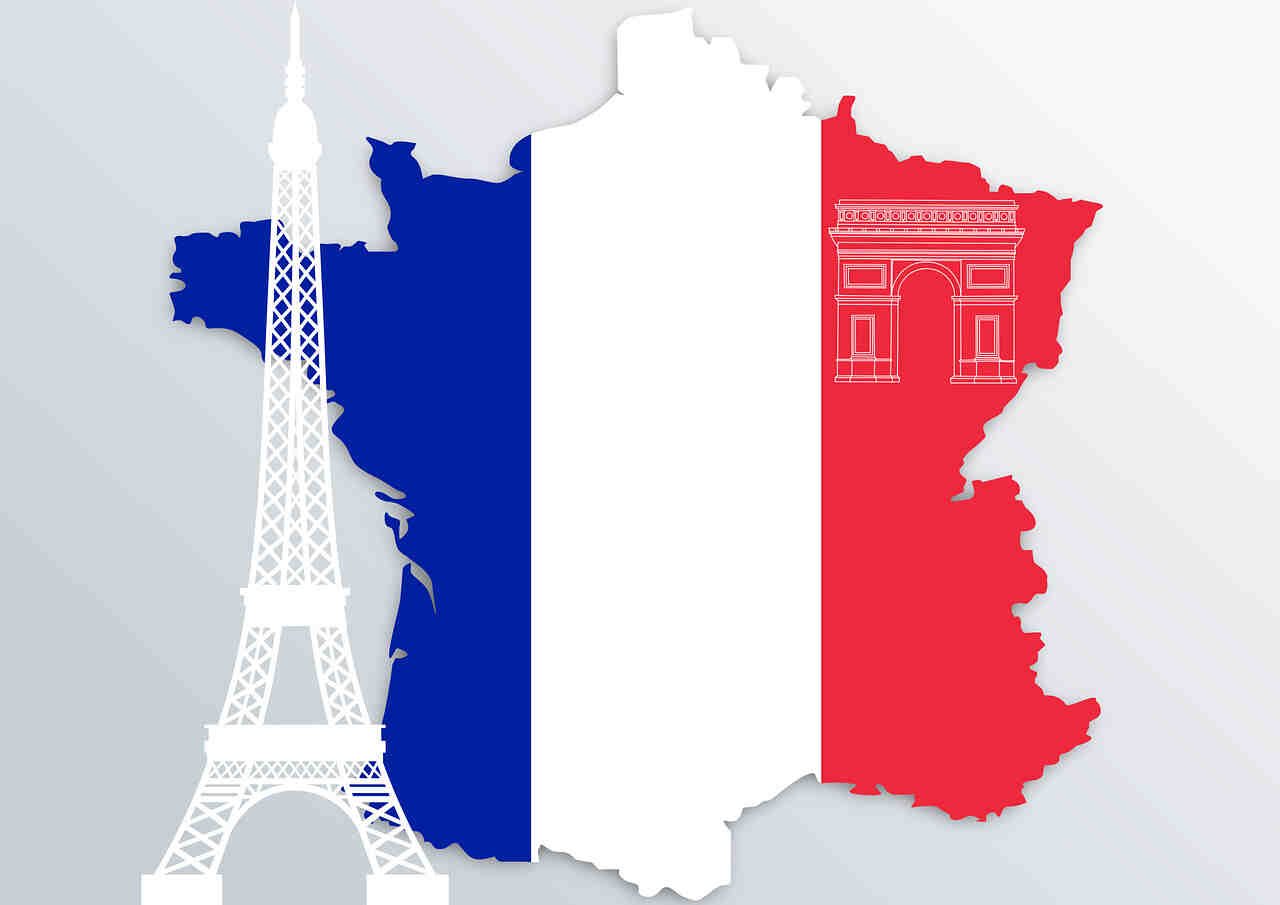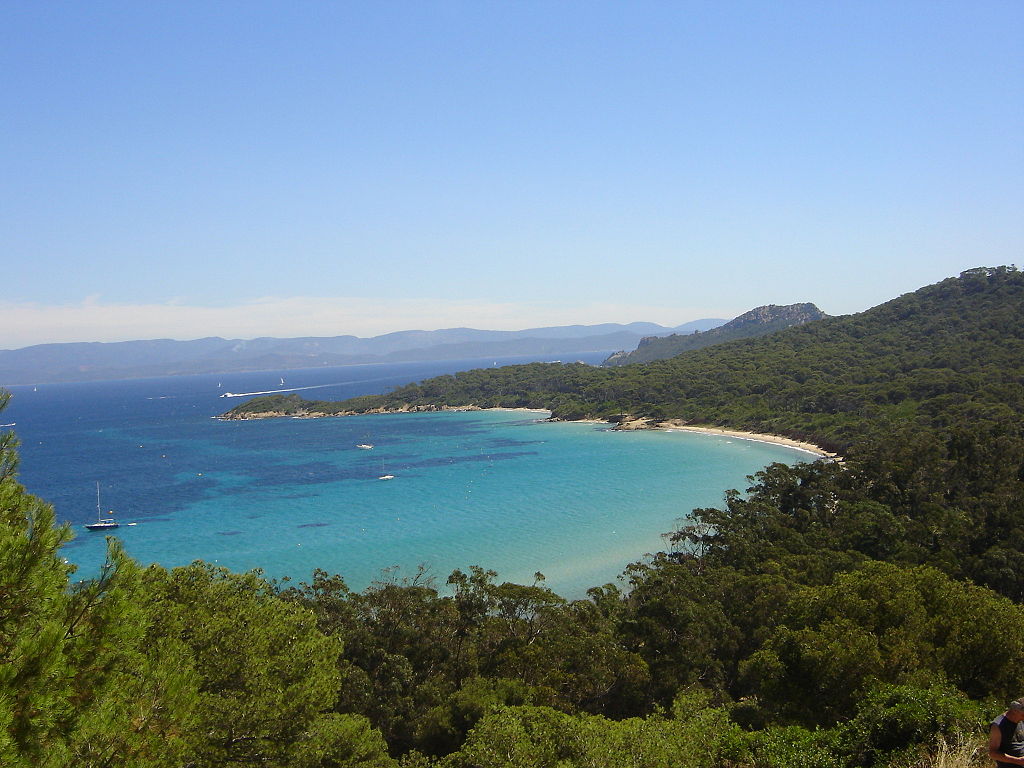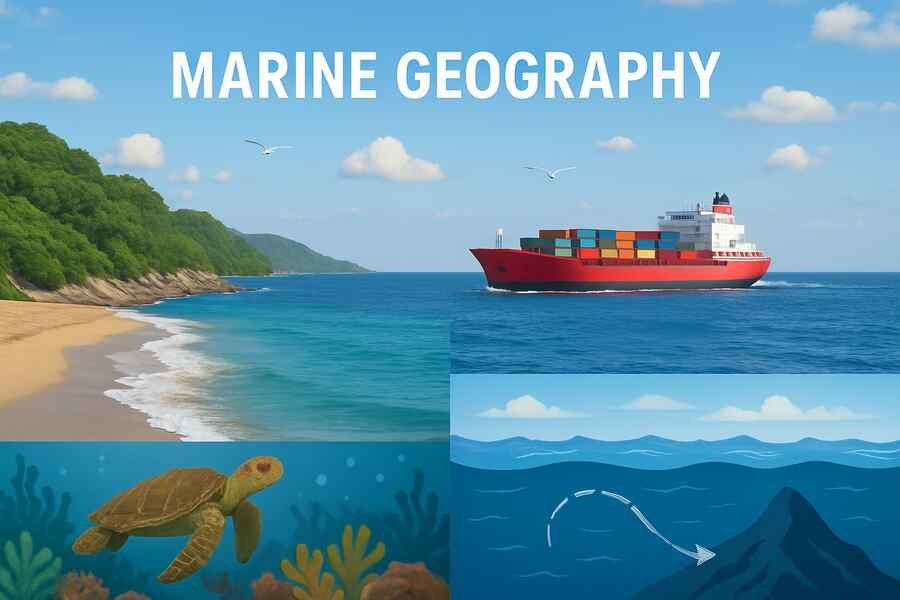Beautiful Cities in France | Must visit at least once in your life
There are many beautiful cities in France and places that you should visit, at least once in your life. Here are the lists:
From wild Brittany to the south of France and its small colorful villages with their feet in the Mediterranean, via the Dordogne and the Arcachon basin, an overview of 30 places of devastating beauty, not to be missed in France.
Paris
Of course, Paris, the capital of France, stands as a major European city and a global epicenter for art, fashion, gastronomy, and culture. Its enchanting 19th-century cityscape is adorned with wide boulevards, all gracefully woven alongside the picturesque River Seine. Unveiling the timeless allure of this vibrant city, Paris showcases a myriad of iconic landmarks, including the awe-inspiring Eiffel Tower and the resplendent 12th-century, Gothic Notre-Dame Cathedral.
Yet, beyond its world-renowned landmarks, Paris is also celebrated for its delightful cafe culture, where moments are savored in the midst of charming bistros and quaint terraces. The city’s allure extends further to the exclusive designer boutiques that grace the renowned Rue du Faubourg Saint-Honoré, captivating discerning shoppers from around the globe.
Explore the romantic charm and rich history that permeate the streets of Paris, and immerse yourself in a tapestry of unparalleled artistry, delectable cuisine, and an ever-present sense of joie de vivre. Visiting this extraordinary city is an experience that transcends time, making it a must-visit destination at least once in your life.

Paris, the city of lights. Paris 16, CC BY-SA 3.0, via Wikimedia Commons
The Gardens of the Palace of Versailles
An architectural symbol of the splendor and decadence of the French aristocracy, the Palace of Versailles still fascinates as much as ever. In the footsteps of the Sun King, Marie Antoinette, Vatel… Visitors can also enjoy the French gardens, a superb creation by André Le Nôtre.

Aerial view of the Domain of Versailles, France. ToucanWings, CC BY-SA 3.0, via Wikimedia Commons
The Palace of Versailles (Le château de Versailles)
Centuries of enlargements, alterations and facelifts have made the Palace of Versailles one of the most sumptuously variegated constructions in the world: the former stronghold of the Sun King is a fabulous cocktail of extravagance, posted about twenty kilometers from Paris. Its park spreads over more than eight hundred grandiose hectares of lawns, French gardens, ponds, neo-classical statues and ultra-sophisticated fountains. Inside, among the 2,300 rooms housed in this baroque behemoth with royal blood, the most spectacular is undoubtedly the famous Hall of Mirrors with its gold leaf and 357 mirrors deployed over 73 meters in length.

Palace of Versailles Gate. Camlamb, CC BY-SA 4.0, via Wikimedia Commons
The Mont Saint Michel
A rocky island of 97 hectares, at the mouth of the Couesnon in Normandy, Mont-Saint-Michel is a French architectural myth in itself. Place of pilgrimage, its fortified city and its immense bay can be visited according to the tides. Which can be fearsome, spreading, according to legend, at the speed of a galloping horse. Another “must do” on site, the Mère Poularde omelet cooked over a wood fire.
Ancestral object of debate between Bretons and Normans, Mont-Saint-Michel is one of the most visited monuments in France. After apprehending the impressive tide, you have to stroll through this timeless city and in particular the abbey, classified as a UNESCO World Heritage Site. And maybe you will be the chosen one who will find the exact location of the mountain!
Porquerolles Island
Favorite island of Edith Wharton, Charlie Chaplin or Chagall, Porquerolles is a little corner of paradise, located less than two hours by boat from Toulon. Classified as a nature reserve, the island has long been closed to the public and its few properties are jealously guarded. Result, past 6 p.m. and the departure of the last boat of daily visitors, the island empties to belong to only a handful of privileged people: lucky owners, vacationers from the few hotels in the area or navigators moored at the port. A rare tranquility, which also helps preserve the wild nature of the island, between vineyards, forests and heavenly beaches.
View of the coast of the island of Porquerolles at Courtade beach. CC BY-SA 3.0, A. Delesse (Prométhée), CC BY-SA 3.0, via Wikimedia Commons
The Dune of Pilat (La Dune du Pilat)
On the Côte d’Argent, just at the entrance to the Arcachon basin, this infinitely famous dune is the highest in Europe. Awakening memories of childhood, this sand dome is climbed for a little while, before we see, at the top, the ocean and the forest of the Landes.
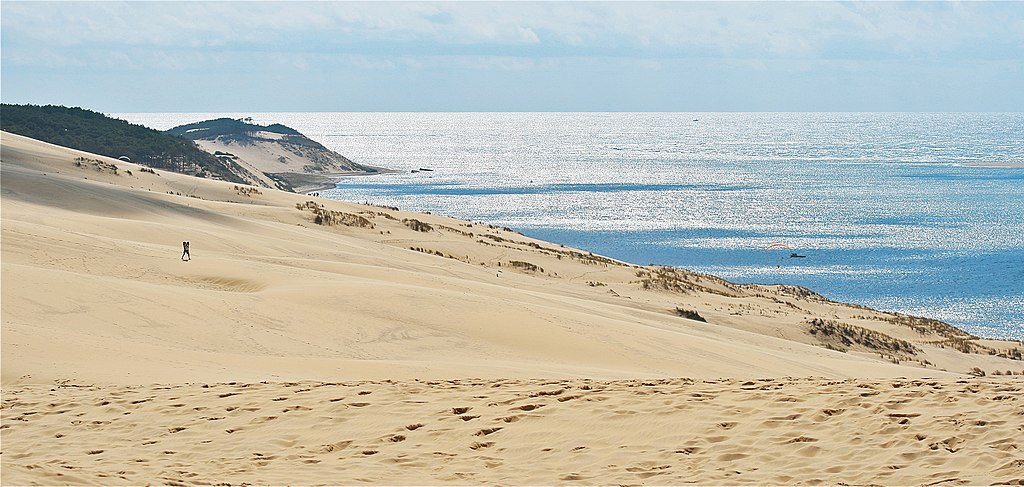
The Pilat Dune and the Atlantic Ocean. Rundvald, CC BY-SA 4.0, via Wikimedia Commons
Claude Monet’s house and gardens in Giverny
Following in the footsteps of Claude Monet’s past life, Giverny immerses its visitors in the nature that inspired the most beautiful paintings by the master of Impressionism. From gardens teeming with flowers and ponds to the painter’s former home transformed into a foundation, the place offers a striking bucolic interlude.
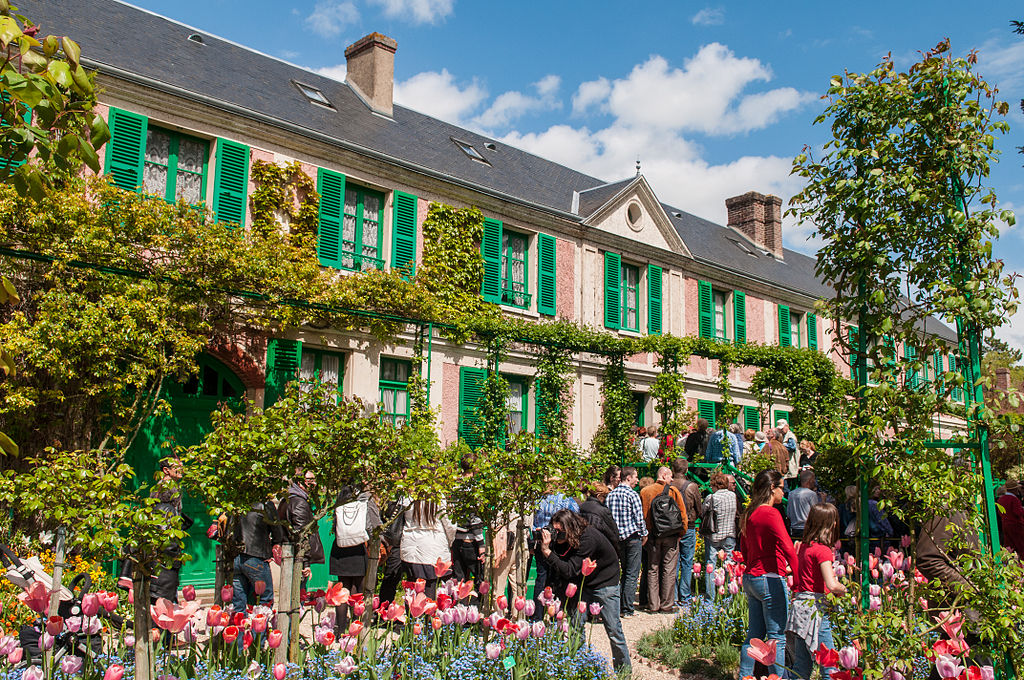
Giverny, (France, Normandy) House of Claude Monet. Michal Osmenda from Brussels, Belgium, CC BY 2.0, via Wikimedia Commons
Nice, French Riviera
In summer as in winter, you will be blown away by the beauty of the capital of the Côte d’Azur (French Riviera). Visiting Nice means strolling on the Promenade des Anglais, enjoying an Italian ice cream or admiring the floats of the mythical Nice carnival. Exploring the treasures of the pretty town, this excursion to the south of France will leave your head full of beautiful memories.

From left to right and from top to bottom: the port, a view from the castle hill, the Ferris wheel, the Promenade du Paillon, a school near the business district, a house in Cours Saleya, a shopping avenue, a view from Mont-Boron. Aeris06, CC BY-SA 4.0, via Wikimedia Commons
The lavender fields in Provence (Les champs de lavandes en Provence)
Inseparable from the common idea that we have of Provence, the lavender fields are part of the “must see” in France. Especially when heading to Luberon, as Simon Porte Jacquemus did for his show celebrating his 10 years as a brand, where they unfurl as far as the eye can see.

Lavender field in Provence. Andyblind, Public domain, via Wikimedia Commons
The cliffs of Etretat
For its fabulous chalk cliff, plunging steeply into the sea, Etretat offers one of the most beautiful panoramas in France. Place of contemplation for artists, such as Matisse or Monet, you can walk there from the large pebble beach, to the heights, populated by Norman houses in the Belle Epoque style.

Falaise d’Aval, a cliff on the Étretat coast with an arch carved out by the water and accessible at low tide. Étretat is a seaside resort in Normandy, France. W. Bulach, CC BY-SA 4.0, via Wikimedia Commons
The creeks of Cassis (Les Calanques de Cassis)
A stone’s throw from Marseille, Cassis, its charming little port and its southern houses clinging to the rock, is home to creeks worthy of the Caribbean. Accessible by boat or after a sporty walk, this heavenly spot is topped by a rocky needle nicknamed the finger of God.

Calanques de Cassis. Elementerre, CC BY-SA 3.0, via Wikimedia Commons
The Gardens of Marqueyssac
Located in the Dordogne, the park of the Château de Marqueyssac extends over 22 hectares. Mixing boxwood, cypress, cyclamen from Naples…. The garden was designed by Julien de Cerval and is one of the most visited places in the region.
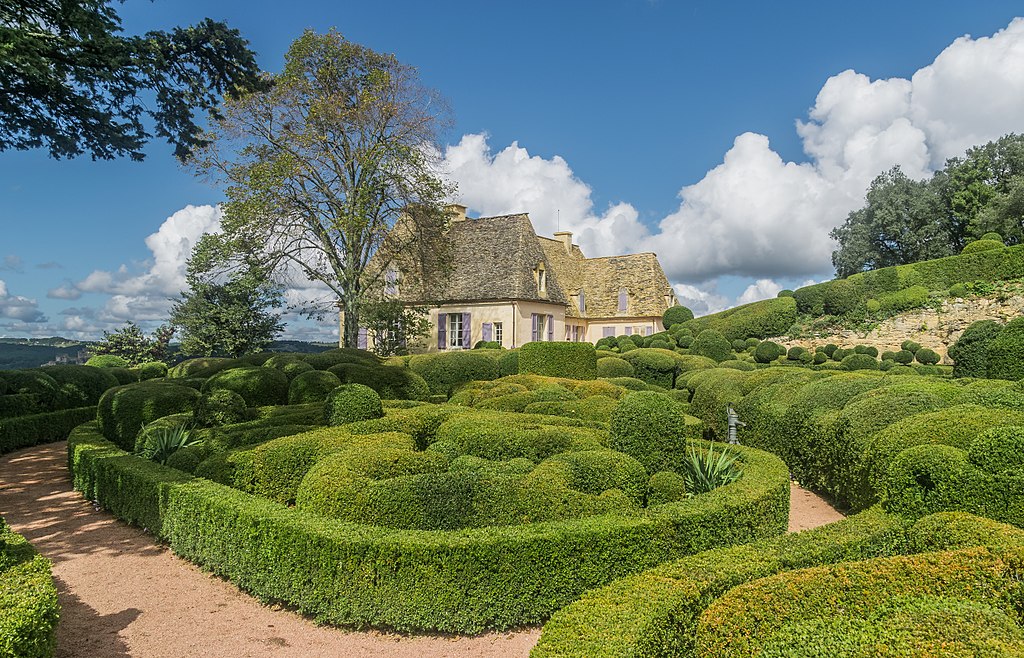
Castle and garden of Marqueyssac. Krzysztof Golik, CC BY-SA 4.0, via Wikimedia Commons
Saignon
Charming village in the Luberon, Saignon compiles all the Provencal elements that make you dream: small stone houses, climbed by ivy, fountains, belvederes where you can admire the lavender fields… All perched on the edge of the Claparèdes plateau.

The village of Saignon. http://www.luberonweb.com, Public domain, via Wikimedia Commons
The Petit-Minou lighthouse (Le phare du Petit-Minou)
With a name that cannot be invented, the Petit-Minou lighthouse culminates above large rocks on the north coast of Brest. Offering a 360-degree panorama of the sea, the place is particularly pleasant at sunset time.
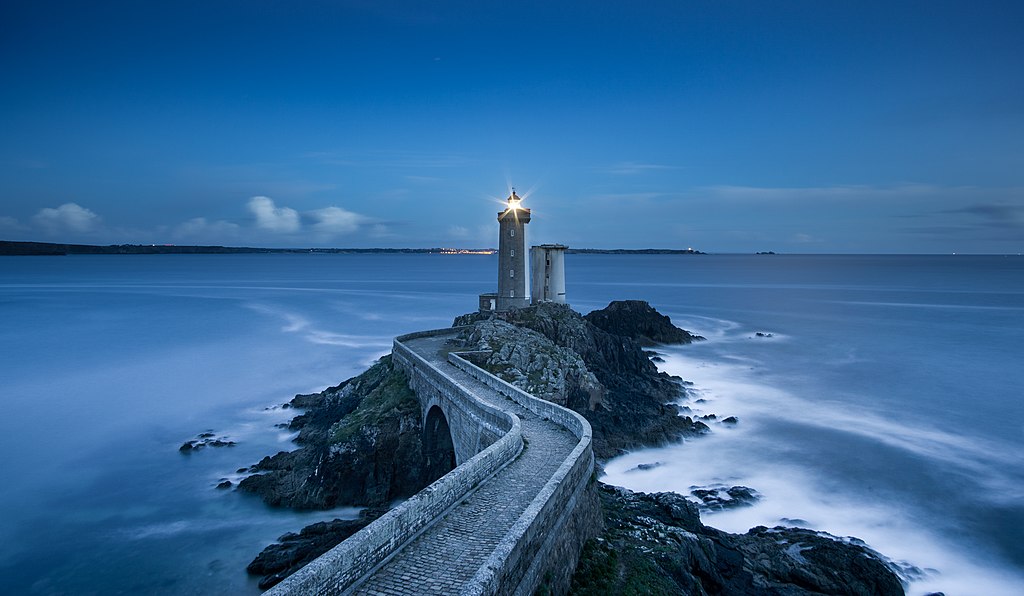
“Petit Minou” lighthouse in Plouzané, France. William Bout williambout, CC0, via Wikimedia Commons
Mougins
Charming village in the hinterland of Cannes, as the south of France does best, old Mougins is a real Provençal postcard. On the heights, we wander through small stone streets, climbed by ivy and squares where fountains are enthroned. Not to mention that you can see, in the distance, the Mediterranean which borders the Croisette.
The castles of the Loire
Amboise, Blois, Chambord, Cheverny Villandry, Chenonceau… The castles of the Loire are more captivating than each other. To visit one by one, where to fly over from a hot air balloon, we discover a substantial part of the history of France.
Verdon Gorge (Les gorges du Verdon)
A sort of French-style Grand Canyon, the Gorges du Verdon form a natural border that has left a deep gash 21 km long in the earth. Between the departments of Var to the south and the Alpes-de-Haute-Provence to the north, in the Provence-Alpes-Côte d’Azur region, board sports enthusiasts descend them in canoes and kayaks. Verdon Gorge is a river canyon located in the Provence-Alpes-Côte d’Azur region of Southeastern France. It is about 25 km (15.5 mi) long and up to 700 metres (0.4 mi) deep.

View of the entrance to the Verdon Gorge with the Lake of Sainte-Croix in the foreground. Olivier Cleynen, CC BY 4.0, via Wikimedia Commons
Ouessant
Preceded by its reputation, Ouessant is one of the wildest islands in Brittany. Populated with green meadows, a very rich fauna and flora, it offers a head-to-head soaring with the elements.

Ouessant is a French island at the southwestern end of the English Channel. Denis Schwartz, CC BY 3.0, via Wikimedia Commons
The Ocher Trail (Le Sentier des Ocres)
Crossing old open-air quarries, this path is one of the most beautiful walks in Roussillon. An unreal landscape, which compiles a fascinating frame of yellow-ocher-orange-red hues, to be admired on two routes of 30min and 1h.
Les Orgues d’Ille-sur-Têt
Made of sand and clay, these jagged cliffs have been forged over centuries and bad weather. Nicknamed “fairy chimneys” they culminate at 10 meters in height and are located not far from Perpignan.
Gard’s Bridge (Le pont du Gard)
Between Uzès and Remoulins, this Roman-inspired stone bridge spans the Gardon. On three floors, it is listed as a UNESCO World Heritage Site and is the fifth most visited monument in France.

Pont du Gard, ancient Roman aqueduct bridge built in the first century AD. Krzysztof Golik, CC BY-SA 4.0, via Wikimedia Commons
Champagne vineyards (Les vignobles de Champagne)
Installed in the Grand Est region (Aube, Marne) and the neighboring departments of Aisne and Seine-et-Marne, the vineyards of Champagne give the opportunity to take a bucolic walk, before tasting a grand cru with a worldwide reputation.
Corsica (La Corse)
Planted in the middle of the Mediterranean, between France and Italy, Corsica is one of those places where time has almost no hold. Between the sea and the mountains, wild vegetation unfolds freely, bordered by crystalline coves and dotted above with small typical villages on the hillside.

The clifftop town of Bonifacio in Corsica. www.rodjonesphotography.co.uk, CC BY 2.0, via Wikimedia Commons
The Val d’Isère glacier (Le glacier de Val d’Isère)
With its kilometers of vertiginous slopes, Val d’Isère is the favorite playground for seasoned skiers. Regularly hosting the most popular competitions and the Olympic Games, the ski resort also shines with its warm atmosphere. As for its glacier, it remains snow-covered all year round.

Aerial view of Val d’Isère ski resort in winter. Mmaconta, CC BY-SA 4.0, via Wikimedia Commons
Lake Annecy (Le lac d’Annecy)
We swim there in the summer, sail there by boat, we walk along the shore… This superb lake facing the mountains has a subtle play of light which has been an endless source of inspiration for many painters.

Lac d’Annecy, France Alps. One of the cleanest lake in the world. Miwok from France, CC0, via Wikimedia Commons
The meander of Queuille (Le méandre de Queuille)
Meander = curves in the channel of a river. A green lung crossed by the Sioule River, the town of Queuille offers a phenomenal panorama of nature. Culminating at an altitude of 250 m (820 ft), the spot is one of the most popular sites in Auvergne.
A meander of the Sioule seen from the town of Queuille, Puy-de-Dôme, Auvergne region. Queuille (French pronunciation: [kœj]; Occitan: Quelha) is a commune in the Puy-de-Dôme department in Auvergne in central France. Photo credit: Jean-Marc Aubelle. Source: Original upload on the french wikipedia by Jim l’Auvergnat (CC BY 1.0) via Wikimedia Commons
The Baux de Provence (Les Baux de Provence)
In a countryside where the wind caresses the olive trees, the crickets sing their serenade, the lavender perfumes the landscape and the sun gilds the skin, Les Baux de Provence bring the south to life at the height of authenticity. At its feet, the quarries of Val d’Enfer, where Jean Cocteau shot in 1959 the Testament of Orpheus.
Lake Mont Cenis (Le lac du Mont-Cenis)
The busiest passage in the Middle Ages, between France and Italy, Lake Mont-Cenis propels its visitors closer to nature. Between lake, mountain and sky, this timeless place allows you to reconnect your good energies.
Between France and Italy, at an average altitude of 2000 meters, lies the plateau of Mont-Cenis. A magical place with a particular micro-climate, endemic flowers that grow nowhere else, mountain pastures well maintained by cows, sheep and farmers.
A space that we like to discover on foot, by bike, with this turquoise-colored lake which can be easily circumnavigated, these carpets of rhododendrons, violets and blueberries which give rise to the cheeses made directly in the farms of mountain pasture, an unforgettable taste.
This place steeped in history deserves that we linger there, that we discover that we crossed the pass by stagecoach and by train, that Montaigne wrote his will at La Ramasse, that Napoleon traced this road and that there was a hospice by the lake…

Mont Cenis Lake on Top of the Mont Cenis Pass, Department of Savoy, Region of Auvergne-Rhône-Alpes (former Rhône-Alpes), France. Zairon, CC BY-SA 4.0, via Wikimedia Commons
The Canal du Midi (Le canal du Midi)
Flowing into the Mediterranean, this canal is listed as a UNESCO World Heritage Site. Considered one of the oldest in Europe, it connects Toulouse to Sète. Pierre-Paul Riquet’s work was carried out in the 17th century to connect the Atlantic to the Mediterranean, crossing the heart of the city and offering green tourist routes and to be visited on foot, by bicycle or by boat.

Canal du Midi in southern France. Peter Gugerell, Vienna, Austria, CC BY-SA 3.0, via Wikimedia Commons
Re island (L’Île de Ré)
With its white houses with gray and green shutters, its alleys lined with vines, reeds, mauves and wisteria, its pine forests that lead to large sandy beaches, its oyster beds that supply the best tables around here… The Ile de Ré has some convincing assets. A stone’s throw from La Rochelle, visitors come to discover a way of life as peaceful as it is pleasant, where daily trips are made by bike and where days on the beach surfing the waves of the Atlantic end with iodized dinners on the terraces or at garden parties in the cozy houses, in blue and white hues.

Saint-Martin-de-Ré and its port seen from the top of the Saint-Martin church. Rundvald, CC BY-SA 4.0, via Wikimedia Commons
Gordes
At the top of the list of the most beautiful villages in Provence, Gordes seduces with its typical stone architecture, but also and above all for its superb view overlooking the Luberon. Most? There is a fabulous hotel there: La Bastide de Gordes.
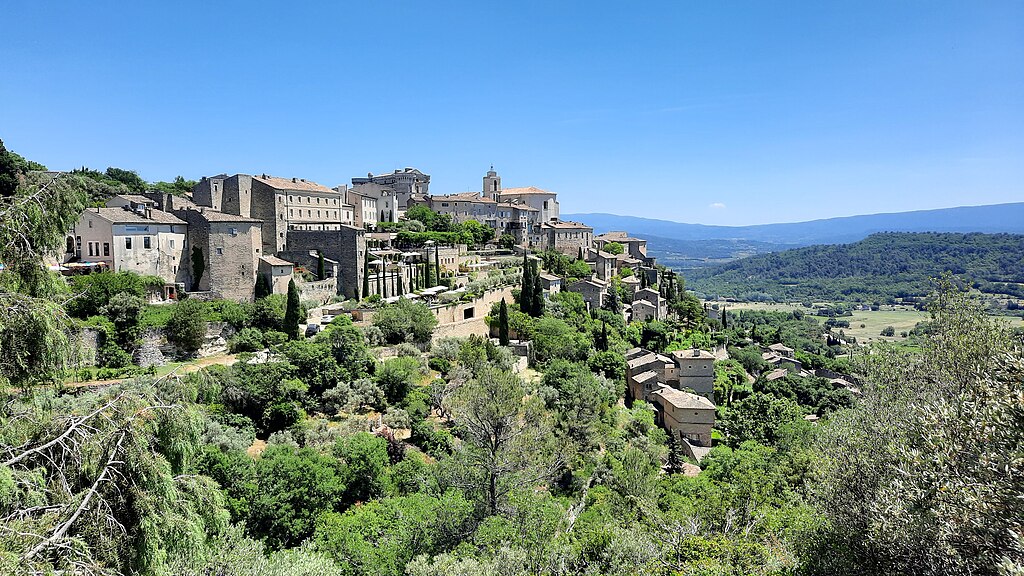
View of the village of Gordes in the Luberon (Vaucluse, France). Mathieu BROSSAIS, CC BY-SA 4.0, via Wikimedia Commons
The Cave of Lascaux (La Grotte de Lascaux)
With paintings and engravings from 17,000 years ago on its walls, the Lascaux cave takes visitors back to prehistoric times. A UNESCO World Heritage site.

Interior of the Lascaux cave. Prehistoric cave painting. JoJan, CC BY 4.0, via Wikimedia Commons
The Golden Dove in Saint-Paul de Vence (La Colombe d’Or)
The atmosphere has not changed much since this golden age of the Riviera when the hotel was the favorite hideout of visiting artists. Jacques Prévert and his gang spent entire summers there, Picasso liked to have lunch there on the terrace, Brigitte Bardot used to take a dip in her swimming pool, Simone Signoret and Yves Montand met there… When visitors discover this charming setting in the elegant simplicity, hard not to fall in love with it. Happiness ? Come and taste the local specialities, treat yourself to a sunbath by the swimming pool lined with a Calder mobile and fall asleep there at nightfall, in one of the rooms overlooking the garden.
La Colombe d’Or hotel, Saint-Paul de Vence, Alpes-Maritimes department, France. BrokenSphere, CC BY-SA 3.0, via Wikimedia Commons
Sources: PinterPandai, VisitParisRegion
Photo credit (main photo): Stux via Pixabay (Pixabay License)
Famous Europe Travel Guide | Bucket List Ideas and Places to Visit
